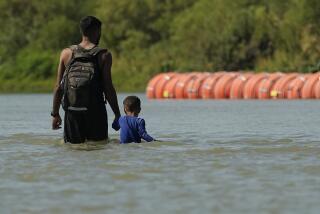Calculated Kindness: Refugees and America’s Half-Open Door, 1945 to the Present,<i> by Gil Loescher and John A. Scanlan (The Free Press: $19.95; 331 pp.) </i>
- Share via
Despite the hoopla surrounding the rededication of the Statue of Liberty and the accompanying rhetoric praising America as the land of freedom and promise for those who seek refuge at its shores, 1986 has already proven to be a bleak year. It took up to 18 months, a lawsuit and the intervention of three members of Congress to secure the release from detention of 32 Afghan refugees who fled persecution first in Afghanistan, then in Pakistan and India. In April the United States Immigration and Naturalization Service opened a detention center in remote Oakdale, La., designed to detain 1,000 or more undocumented aliens. People living as far away as New York, Miami and California have been transported to Oakdale even when they have families or attorneys in the states where they were arrested. Religious and lay activists in Arizona dismayed by the government’s practice of refusing asylum to Central American refugees and deporting those refugees back to countries where they face political persecution or death were convicted of violating federal statutes that prohibit smuggling, transporting or providing aid and comfort to undocumented aliens. In Los Angeles lawsuits are pending to prevent the INS from indefinitely detaining undocumented alien children and youths who come to the United States without their parents, even when grandparents, aunts, uncles and older siblings come forward to assume responsibility for them; and to prevent the INS from engaging in tactics that scare El Salvadoran refugees into “voluntarily” returning to El Salvador.
While these practices are of current concern to refugee advocates, they are not isolated occurrences. As Gil Loescher and John A. Scanlan make clear in their exhaustive study of United States refugee policy since 1945, the underlying political considerations that are the foundation for such practices have been an unrelenting part of American immigration and refugee policy for over 40 years. According to the authors, United States immigration policies are directly linked to anti-Communist foreign policy goals. Both Republican and Democratic administrations have been determined to prove that many citizens of communist countries who are prevented from voting for freedom at the ballot box will vote with their feet.
Acknowledging that humanitarian concerns have also been a factor in United States immigration policy, the authors are critical of the failure of the federal government to be moved by humanitarian concerns when they conflict with political goals. They write, “When (humanitarian and political) motives are linked, concern over the fate of hundreds of thousands of people who are starving, or fearful of persecution on political grounds, or both, goes hand in hand with . . . the positive political gains to be made by presenting a negative image of Communist rule. When no linkage exists, however, humanitarian motives have been almost always overwhelmed by political calculation. Thus it is not accidental that over 90 percent of all the special admissions permitted between 1948 and the present have involved individuals fleeing Marxist regimes. Nor is it accidental that many of those we have turned away--Chileans, Salvadorans, Korean dissidents--have been labeled as ‘left-wing’ troublemakers.”
The authors document the stories of each successive wave of political immigrants who have sought entry into the United States since World War II, including Jews and displaced persons in Europe, Hungarians, Cubans, Czechs, Chileans, Vietnamese boat people, Cambodians, Haitians and Central Americans. In doing so they analyze the executive decision-making processes and Congressional action or inaction that determined which refugees would be admitted and the rate of their entry.
Their saddest tales are those of delay and of abandonment of refugee groups whose resettlement in the United States was no longer politically expedient or popular. For example, three chapters of the book are devoted to the refugee crisis in Southeast Asia that followed in the end of the Vietnam war and the Khmer Rouge victory in Cambodia. While the United States came quickly to the aid of Vietnamese allies who sought to escape from Vietnam at the end of the war, the country was slow in formulating a resettlement policy for the boat people who fled in later years. Similarly, although the State Department was aware of the atrocities being committed by the Pol Pot regime in Cambodia, years passed before an organized resettlement effort for Cambodians was initiated. It was only when accounts that pirates were raping and robbing the boat people, that countries of first asylum were turning their rickety boats back to sea, and that thousands had met their death through torture, physical abuse and starvation in Cambodia roused public opinion that the executive branch was prepared to act. Even then the motives in offering large-scale resettlement were as much to alleviate the pressure friendly countries of first asylum in Southeast Asia were enduring as they were to provide desperately needed humanitarian assistance. And, when public outcry in the United States subsided, so did the resettlement programs.
Loescher and Scanlan’s extensive research, which is evidenced by more than 100 pages of references, and their factual, jargon-free presentation have made possible the production of a major contribution to the literature on the history of United States immigration policy. This book deserves the attention of refugee advocates and all readers who struggle to understand the harsh, anti-humanitarian and sometimes legally questionable refugee policies that persist in blatant contrast to the myth that America is, in Ronald Reagan’s words, an “island of freedom here as a refuge for all those people who yearn to breathe free.”
More to Read
Sign up for Essential California
The most important California stories and recommendations in your inbox every morning.
You may occasionally receive promotional content from the Los Angeles Times.










